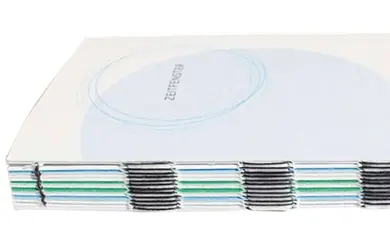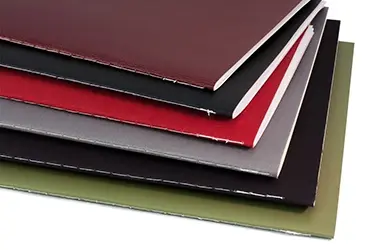
Custom Open Thread Stitching, Thread Knot Binding, and Cross Stitch Binding from Berlin
The benefits of custom open thread stitching, thread knot bindings, and cross-stitch bindings, which are not only functional but also aesthetically pleasing. These binding methods are ideal for giving books, brochures, or creative projects a unique and handcrafted character.
In addition to classic adhesive bindings, we offer a wide range of thread-bound alternatives. Whether open thread stitching, thread knot binding, or cross-stitch binding – all techniques can also be applied to custom formats. This makes it possible to execute projects that are not suitable for adhesive bindings without compromising on quality and exclusivity.
Our open thread stitching leaves the spine visible and emphasizes the handcrafted aesthetic. The thread knot binding, where pages are sewn with colored thread, gives small editions like brochures or notebooks a noble and individual style.
Open Thread Stitching – Tradition Meets Aesthetics

Open thread stitching is a technique that meets both functional and aesthetic demands. In this method, printed sheets are first processed into folded layers and then sewn together at the spine with threads. What makes this technique special is that the spine remains exposed, showcasing the thread structure, which creates a unique, handcrafted appearance.
This binding can be flexibly combined with softcover or hardcover covers. For a minimalist look, it can also be done without a cover. Open thread stitching is particularly well-suited for magazines, presentations, memory books, or wedding newspapers – and can be executed up to A4 size.
In addition to choosing various threads, finishing options such as embossing or corner protectors are available to make your project unique and high-quality. Open thread stitching gives every printed product a handcrafted touch that will impress.
Choose open thread stitching for your next project – handcrafted, high-quality, and individually designed at our printing house in Berlin.
Thread Knot Binding – Traditional Craftsmanship with Style

Thread knot binding is a classic and craft-intensive technique that adds an elegant and individual touch to your printed products. In this traditional bookbinding method, the pages are first gathered into folds and then sewn together with colored threads. This hand-bound process, also known as saddle stitching, is distinguished by its sophisticated look and durability.
Thread knot binding is particularly suitable for small brochures – starting from just 8 pages. It offers an exclusive alternative to other binding methods, especially when technical requirements such as minimum page count cannot be met.
This binding method also offers numerous additional options:
- Selection of colored threads to match the design.
- Finishing options like embossing that can complement the cover.
- Flexible design possibilities for creative and high-quality projects.
Explore the possibilities of thread knot binding – traditionally, individually, and expertly crafted in Berlin.
Stitch Binding – Stability and Style in One Binding

The saddle stitching is one of the most stable and durable binding methods. Unlike the classic adhesive binding, the pages are printed in the form of folded sheets, collected, and then sewn together with colored thread, with or without a cover. This technique provides a stylish and high-quality alternative to the wire stitch binding, which is commonly used for brochures.
The Origin of Saddle Stitching
Saddle stitching was originally developed for secure products such as passports, as it offers high stability and security. Today, this binding method is increasingly used for notebooks, diaries, and brochures, benefiting from its durable and elegant craftsmanship.
The advantages of saddle stitching
- Durability: The thread binding withstands frequent use without compromising its strength.
- Flexibility: Can be used with or without a cover.
- Aesthetics: Colored thread gives the binding a stylish appearance.
- Application: Ideal for small and medium print runs where design and stability are a priority.
Opt for saddle stitching – a high-quality alternative for durable and stylish print projects.
Thread Binding - Origins and History
The History of Thread Binding – Tradition Meets Modernity
Thread binding is one of the oldest and most refined bookbinding techniques, perfected over centuries to create durable and aesthetically pleasing books. In this article, you will learn more about the origins and developments of thread binding, as well as its related techniques such as open thread binding and thread knot binding.
The Beginnings of Thread Binding – The Evolution of Bookbinding Art Through the Ages
Thread binding was developed in the 15th century, as the demand for stable and durable books grew. It revolutionized book production by stitching folded sheets together with threads, creating a binding that allowed books to open flat and remain durable.
Origin of Thread Binding
- The technique originated from the need to bind manuscripts and Bibles securely and durably.
- With the invention of the printing press, thread binding became the standard for high-quality books.
Technical Development of Thread Binding
- Originally hand-sewn, the technique was mechanized during the Industrial Revolution.
- Today, thread binding remains the preferred method for durable book bindings.
Thread Knot Binding – A Traditional Technique with a Modern Flair
Thread knot binding, also known as school booklet binding, is a hand-bound method particularly suitable for smaller editions and booklets. This technique gives printed products like brochures and notebooks a unique and elegant appearance.
Origins of thread knot binding
- Historically, it was used for small manuscripts and notebooks.
- The use of colored threads also made it visually appealing.
The significance of thread knot binding today
- Ideal for exclusive projects and small editions.
- A sustainable alternative to glue bindings for low page count.
Open Thread Binding – The Aesthetics of Visibility
Open thread binding highlights the structure of the book spine, combining functionality with aesthetics. It is particularly suitable for creative projects that value design and craftsmanship.
The origin of open thread binding.
- Developed to make the thread structure visible and emphasize the craftsmanship.
- Especially appreciated for magazines and creative book projects.
Application in today's time.
- Popular for magazines, wedding newspapers, and company presentations.
- It allows a combination with softcover or hardcover bindings, or a minimalist look without a cover.
Why Thread Binding is Unmatched Then and Now
Die Fadenheftung bietet zahlreiche Vorteile, die sie zur bevorzugten Methode für hochwertige Buchbindungen machen.
- Thread binding offers numerous advantages, making it the preferred method for high-quality bookbinding.
- Flexibility: Suitable for various formats and creative projects.
- Aesthetics: Gives books and brochures a high-quality appearance.
Although modern alternatives like perfect binding are widespread, thread binding remains the top choice for durable and attractive print products.
Experience the art of thread binding in modern perfection. Contact us and create your custom project at our printing house in Berlin.
For more detailed information on book printing and all available binding options, instructions for file creation, and a
price calculator and online order form (DE)
